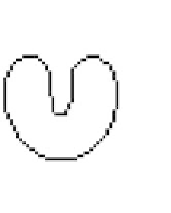Biomedical Engineering Reference
In-Depth Information
row of Fig. 10.8 show the region map used for the RAGS formulation outlined
later in this chapter and the converged RAGS snakes. This figure also illustrates
the power of the geometric snake in splitting to find multiple objects.
10.3 The Geometric GGVF Snake
In this section we briefly introduce the geometric GGVF snake and consider
its advantages and shortcomings. Later in the chapter, the GGVF snake will
be used along with the standard geometric snake to make comparisons to the
performance of RAGS.
The gradient vector flow (GVF) active contour was first introduced by Xu
et al
. [7] in a parametric framework. The authors proposed a new external force:
a diffusion of the gradient vectors of a gray level or binary edge map
derived
from the original image. The GVF goes some way toward forcing a snake into
boundary concavities while providing a larger capture range due to its diffused
gradient vector field. Figure 10.9 (right) shows the diffused gradient vectors for
a simple object in Fig. 10.9 (left). The traditional potential force is shown in
Fig. 10.9 (center).
The same authors have also introduced the GGVF, a generalized GVF snake
model. The GGVF improves the GVF by replacing the constant weighting factor
with two spatially varying weighting functions, resulting in a new external force
field. The weighting factors provide a trade-off between the smoothness of the
GVF field and its conformity to the gradient of the edge map. The result is
Figure 10.9: GVF field compared to traditional potential force vector field. From
left: a simple line-drawing U shape (binary) image, the traditional potential force
vector field, and GVF field (from [8],
c
2003 IEEE).


